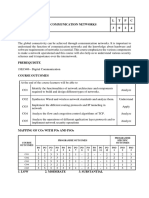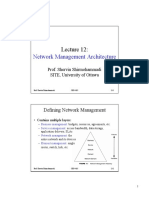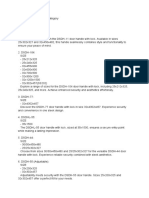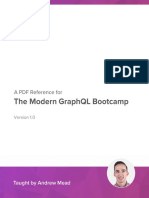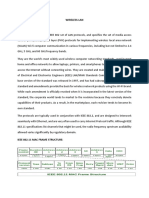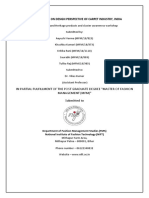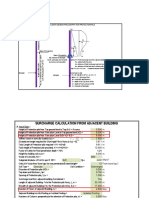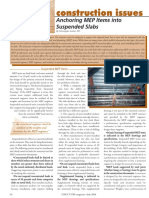Lecture 4:
Introduction to
Computer Network Design
Prof. Shervin Shirmohammadi
SITE, University of Ottawa
Prof. Shervin Shirmohammadi CEG 4185 4-1
Computer Networks
Prof. Shervin Shirmohammadi CEG 4185 4-2
1
� Background
• Network design has generally been considered an
art consisting of a set of rules acquired through
experience.
– For example the 80/20 rule where 80% of a network’s
traffic is local and 20% is remote.
– “Bridge when you can, route when you must”. Based on
an antiquated view that bridging was easier and cheaper.
• Network technologies and requirements have
increased tremendously. There are many options
available now.
Prof. Shervin Shirmohammadi CEG 4185 4-3
Factors that affect Network Design
• Capacity planning (a major factor in the design of the
network).
– Generally the solution to a problem will be “throw bandwidth to
the problem”. Sometimes and especially recently it offers some
relief but it is does not solve all problems.
• Delay performance
– Has become very important in real-time services and needs to
be optimized.
• Network Reliability, Maintainability, and Availability
(RMA).
– A factor that is really important for customer satisfaction.
Prof. Shervin Shirmohammadi CEG 4185 4-4
2
� The Technical View
• A “Network” really can be thought of as of three things
and they all need to be considered when working on a
network design project
– Connections
– Communications
– Services
• Connections: provided by Hardware that ties things
together
– Wire/Fiber Transport Mechanisms
– Routers
– Switches/Hubs
– Computers
Prof. Shervin Shirmohammadi CEG 4185 4-5
The Technical View (…)
• Communications: provided by Software
– A common language for 2 systems to communicate
with each other.
– Interoperability Protocols
• TCP/IP (Internet/Windows NT), IPX / SPX (Novell Netware
4), AppleTalk, etc.
• Services: the Heart of Networking - specially important
today: the Internet in particular is moving quickly from a
connection emphasis to a service oriented network.
• Cooperation between 2 or more systems to perform some
function – Applications driven
– telnet, ftp, http, SNMP, UDP, etc.
Prof. Shervin Shirmohammadi CEG 4185 4-6
3
� High Level View of Network Design
Section 1 Section 2 Section 3
(Conceptual Model) (Logical Model) (Physical Model)
Analysis Architecture Design
Requirements, Relationships within and
Flows, Risks between Network Technology, Equipment
Functions Choices, Connectivity
Choices
Prof. Shervin Shirmohammadi CEG 4185 4-7
Overview of Network Analysis
• State of existing network
• Problems with existing network
• Network goals
• Requirements from users, applications, devices
Network
Analysis
• Description for requirements for the network
• Descriptions of traffic flows
• Mappings of applications and devices to network
Prof. Shervin Shirmohammadi CEG 4185 4-8
4
� Overview of Network Architecture
• Description for requirements for network
• Descriptions of traffic flows
• Mappings of applications and devices to network
Network
Architecture
• Reference architecture for network (end to end structure).
• Relationships between functions (routing, management, performance, security).
• Descriptions of interactions, trade-offs, dependencies, and constraints.
Prof. Shervin Shirmohammadi CEG 4185 4-9
Overview of Network Design
• Reference architecture for network
• Relationships between network functions
• Descriptions of interactions, trade-offs, dependencies, and constraints.
Network
Design
• Physical details, evaluate and choose technologies.
• Strategies for interoperability.
• Evaluation criteria.
Prof. Shervin Shirmohammadi CEG 4185 4-10
5
� Hierarchy
Levels of Hierarchy Levels of Diversity
Core
Access … … … … … … … … …
End Users
Hierarchy: degree of concentration of traffic flows at interconnection
points
Prof. Shervin Shirmohammadi CEG 4185 4-11
Network - 1 Level
Broadcast Domain
Flat Bridged or Switched Network: what is the problem with this?
Prof. Shervin Shirmohammadi CEG 4185 4-12
6
� Network - 2 Levels
Broadcast Domain
Broadcast Domain
Broadcast Domain
What is the hierarchy degree?
Prof. Shervin Shirmohammadi CEG 4185 4-13
The Need for Diversity
Flows are forced through hierarchy
Network
Network Network
Network Network Network Network
Prof. Shervin Shirmohammadi CEG 4185 4-14
7
� Flows Improvement with a CDN
Network
Network Network
Network Network Network Network
CDN
Content Delivery Network provides direct connectivity
Diversity (aka, Interconnectivity, aka Redundancy): interconnecting
the network at different levels to achieve desired performance.
Prof. Shervin Shirmohammadi CEG 4185 4-15
Network & System Complexity
4th Generation – Decision-making
Complexity
Interactions
3rd Generation – Services
Interactions
2nd Generation – Interoperability
1st Generation – Connectivity
Where are we today?
Prof. Shervin Shirmohammadi CEG 4185 4-16
8
� Architecture & Design Defensibility
• Very important and often overlooked part of network analysis and
design.
– During analysis you are gathering data and making decisions.
– Details about how one got to those decisions is generally lost.
– It is important to keep an audit trail.
• A set of documents, data, and decisions for the architecture and design.
– This audit would answer questions like:
• Why did you choose this technology?
• Why does it cost this amount?
• Time spent at this phase can save large amount of time and resources
later.
• What type of information? (Time stamp it)
– Requirements (What type of Network Requirements would you expect?)
– Problem definitions (There is no end to these).
– Goals, Decisions
– Data (What type of data?)
Prof. Shervin Shirmohammadi CEG 4185 4-17
A Systems Methodology
• The idea is to view the network and a subset of its environment
(what it impacts or interacts with) as a system.
– This primarily implies looking at the services associated with the network
(3rd generation networks).
– Interactions and dependencies between the network its users, applications,
and devices arises from this analysis.
• Traditional Device
Device
view of a
system Network
• Better generic
components of a User User
system
Application Application
Device Device
Network
Prof. Shervin Shirmohammadi CEG 4185 4-18
9
� Comparison to OSI
Application
User
Presentation
Session
Application
Transport
Network Device
Data Link
Physical
Network
OSI System Levels
Prof. Shervin Shirmohammadi CEG 4185 4-19
Service Characteristics
• Service Characteristics: individual network performance and
functional parameters that are used to describe the network.
– These can be considered as requirements from the network.
– E.g.:
• Providing 1.5 Mb/s peak capacity to a user
• Guaranteeing a maximum RTT of 100 msec
• Defining a specific security level for a group of users
Functional Non-Functional
Security Capacity
Manageability Delay
Billing RMA
User-server
WAN
WAN service LAN-WAN
Prof. Shervin Shirmohammadi CEG 4185 4-20
10
� Service Metrics
• Service Metrics: measurements of characteristics in the actual
network to monitor, verify, and manage services.
• Services must be described and provisioned end-to-end at all
network components between well-defined demarcation
points.
– Otherwise some components might not be capable of supporting the
services.
• Services must also be configurable, measureable, and
verifiable within the system to ensure that applications, users
and devices are getting the services requested
– Leads to accounting and billing
• How: using service metrics.
Prof. Shervin Shirmohammadi CEG 4185 4-21
Service Levels
• Service Levels: grouping of a number of service characteristics.
• E.g., combining capacity (1.5 Mb/s) and reliability (99.99%
uptime).
• Can be offered by service providers to customers, in packages:
– Basic (No Priority)
– Gold (High Capacity)
– Platinum (High Capacity, Reliability, Low Delay)
Prof. Shervin Shirmohammadi CEG 4185 4-22
11
�System Components & Network Services (1)
GigE GigE OC-48 OC-48 GigE FE
POS/O
C-48
GigE User PCs
Servers GigE Router Router
Switch (100)
(4) Switch
Possible Demarcation Points
10
Potential aggregate
capacity (Gb/s)
0.1 1
Distance along transmission path
Prof. Shervin Shirmohammadi CEG 4185 4-23
System Components & Network Services (2)
GigE GigE OC-48 OC-48 GigE FE FE FE
POS/O
C-48
Servers GigE Router Router GigE Firewall FE User
Switch Switch Switch PCs
(4)
(100)
Potential aggregate
10
capacity (Gb/s)
0.1 1
Distance along transmission path
Prof. Shervin Shirmohammadi CEG 4185 4-24
12
� Types of Network Service
• Best-effort service
– No control how the network will satisfy the service request.
Unpredictable and unreliable service with variable
performance.
• Guaranteed service
– Opposite of best-effort service. Predictable and reliable.
Implies a contract between the user and the service provider.
• Predictable service
– Some degree of predictability without accountability.
Service requirements must be configurable, measurable, and
verifiable. Control of the system is required.
Prof. Shervin Shirmohammadi CEG 4185 4-25
Best Effort Performance
• Fast Ethernet Resource
Loading
100
Capacity Fast Ethernet (Mb/s)
Congestion begins
Capacity to load network
Available
Throughput
50
0
Number of Concurrent Traffic Flows
Prof. Shervin Shirmohammadi CEG 4185 4-26
13
� Guaranteed Performance
• Telephony network, with Call Admission Control (CAC)
Resource System Resources are
100
fully loaded at this
Capacity Fast Ethernet (Mb/s)
Loading
point
No more calls allowed until resource
50
are available
As calls are
added resource
loading
increases
0
Number of Concurrent Traffic Flows (Calls)
Prof. Shervin Shirmohammadi CEG 4185 4-27
Best Effort vs. Guaranteed
• Best Effort: allows maximum number of traffic flows,
but performance degradation likely.
• Guaranteed: performance will be met, but fewer traffic
flows can be accepted.
• Many applications need a hybrid of the two
(Predictable Effort).
– E.g., VoIP requires characteristics of CAC while operating
on top of best-effort Internet.
Prof. Shervin Shirmohammadi CEG 4185 4-28
14
� Performance Characteristics
• Capacity – is a measure of the system’s ability to
transfer information (voice, data, video, etc).
• Delay – is a measure of the time difference in the
transmission of information across the system.
• RMA – refers to Reliability, Maintainability, and
Availability
Prof. Shervin Shirmohammadi CEG 4185 4-29
Capacity
• Bandwidth: theoretical capacity of one or more network devices
or communication links in the system.
– Raw capacity does not take into account overhead from higher-layer
protocols or performance loss due to device inefficiencies.
• Throughput: is the realizable capacity of the system or its
network devices.
• E.g., theoretical SONET OC-3c link capacity (bandwidth) is
155.52 Mb/s
– This does not include data-link, network, or transport-layer protocol
overhead.
– Performing at line rate when T=155.52 Mb/s
• In reality, when tested with TCP, SONET OC-3c link capacity
(throughput) is 80 to 128 Mb/s
– Where does the majority of this overhead coming from?
Prof. Shervin Shirmohammadi CEG 4185 4-30
15
� Delay
• Sources:
– Propagation, transmission, queuing, and processing
• There are several ways to measure delay
– Direction (end-to-end, round-trip)
– Latency – time it takes to process information and reply.
E.g., response time of a network device.
– Jitter or delay variation – change in delay over time. Real-
time and near real-time require strict delay variation.
• Jitter is NOT delay
Prof. Shervin Shirmohammadi CEG 4185 4-31
RMA
• Reliability: a statistical indicator of the frequency of failure of the
network.
– Represents un-scheduled outages of services.
– Predictable behavior – delivery of information must occur within well-
known time boundaries.
– Analogy: air travel. Passengers expect flights to depart and arrive within
reasonable boundaries.
• Maintainability: a statistical measure of the time to restore the
system to fully operational status after it has experienced a fault.
– It is generally expressed as a mean-time-to-repair (MTTR).
– One has to be somewhat careful with this value since it usually assumes that
logistics (ordering and receiving a burned out device) time is not included.
• Availability: relationship between the frequency of mission-
critical failures and the time to restore the service.
– Defines as the mean time between failures divided by the sum of mean time
to repair and mean time between failures:
A = (MTBF) / (MTBF + MTTR)
Prof. Shervin Shirmohammadi CEG 4185 4-32
16
� Performance Envelopes
• A combination of two or more performance requirements with
upper and lower thresholds for each.
Appl 1
Appl 4
106
105 Appl 2
Data Size (Mbytes)
104
103
102 Appl 3
101
Appl 5
100
10-4 10-3 10-2 10-1 100 101 102
1/Delay (Seconds –1)
Prof. Shervin Shirmohammadi CEG 4185 4-33
Network Supportability
• Post-implementation costs (80% of network life cycle cost
are the operations and support costs)
– Network and system reliability
– Network and system maintainability
– Training of operators
– Quality of staff to perform maintenance
• What affects this
– Degree of redundancy in critical path components.
– Quality of network components
– Location and accessibility of components
– Implementation of test and monitoring equipment
Prof. Shervin Shirmohammadi CEG 4185 4-34
17





















